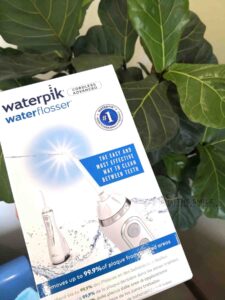What is water flosser
Brushing your teeth twice daily with fluoride toothpaste is a good start. But it may be not enough to clean the plaque or food stuck in between the teeth. Therefore, dentists recommend interdental cleaning such as flossing. However, flossing can be difficult to master for beginners and braces patient. Good news! Have you heard of something called water flosser?
Water flosser or oral irrigator is a handheld device that sprays strong water jet to remove plaque and food stuck in between teeth and along the gum line.

Is it something new? The first oral irrigator was developed by a dentist in US called Gerald Moyer in 1962. He was helped by his patient John Mattingly who was a hydraulic engineer by profession. The company began as Aqua Tec Corporation and was listed as Water Pik Technologies in 1999.
Today, Waterpik is the most known brand and one of the best water flosser in the market with American Dental Association (ADA) seal. Products accepted by ADA meet strict criteria that prove they are safe and effective. It comes with cordless and countertop models to suit individual need.
How it work?
As a matter of fact, simple swishing with water is ineffective to remove dental plaque. Uniquely, water flosser generates strong water jet (45-100 PSI or 3.102-6.895 bar). The combination of pulsation and pressure produced by the water flosser created shear hydraulic forces that effectively removed the plaque biofilm to
- Improve gum health
- Remove plaque and bacteria
- Reach areas that you can’t get to with a toothbrush or string floss
Water Flosser also addresses specific dental needs including cleaning braces and orthodontics, periodontal pockets, and cleaning implants and dental work such as crowns, bridges, and veneers. (1) For people with arthritis, it is easier to use water flosser than string floss.
Pros
- Easy to use
- Able to clean hard to reach areas
- Effective for braces, perio, implant, crown and bridge patients.
Cons
- May not remove ALL plaque
- Can be costly
- Messy
Scientific Evidence
According to research done at the University of Southern California Center for Biofilms, a three-second water flossing application is effective to remove 99.9% plaque biofilm. When observed via scanning electron microscopy, researcher found that the shear hydraulic forces were able to effectively remove plaque biofilm. (2)
However, if optimum toothbrushing is achieved, oral irrigator may not have extra beneficial effect in reducing visible plaque. (3)
Final Verdict
Therefore, our dentists recommend water flossing as an effective adjunct to normal oral hygiene practice. But it should not completely replace manual toothbrushing and string flossing. However, it is proven to be an effective tool to enhance cleaning for difficult to reach areas and patient with braces.
Reference
- Sharma, N; Lyle, D; Qaqish, J; Galustians, J; Schuller, R (2008). “Effect of a dental water jet with orthodontic tip on plaque and bleeding in adolescent patients with fixed orthodontic appliances”. American Journal of Orthodontics and Dentofacial Orthopedics. 133 (4): 565–71
- Gorur A, Lyle DM, Schaudinn C, Costerton JW. Biofilm removal with a dental water jet. Compend Contin Educ Dent. 2009;30(Spec No 1):1–6.
- Husseini, A; Slot, DE; Van der Weijden, GA (2008). “The efficacy of oral irrigation in addition to a toothbrush on plaque and the clinical parameters of periodontal inflammation: a systematic review”. Int J Dent Hyg. 6 (4): 304–14.
